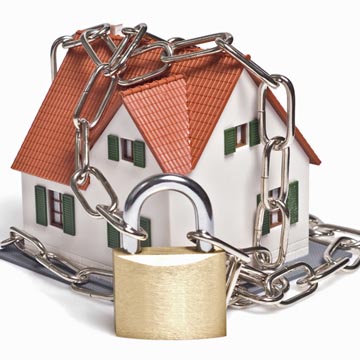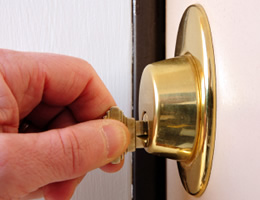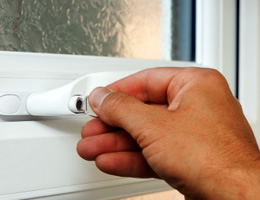
Secure your home
When we think of a burglar, we think of a stereotypical ski-masked man dressed head to toe in black, crouched down, creeping in the dead of night, carrying a professional break-in artist's ideal toolkit. As common a culprit, however, is the average-looking person dressed in average street clothes on your average workday, entering via an unlocked door or a brick-induced hole in a glass door.
There's no time of day in which your home is immune from burglaries; there are no standards of practice when it comes to how a burglar breaks in. Homes are victims of burglary any time. The typical homeowner suffers a loss of nearly $2,000 in stolen goods or property damage.
Of the reported 2 million commercial and residential burglaries reported to the U.S. Department of Justice in 2009, most (61 percent) were forcible entry. 32.6 percent of burglars found the easy way in, and the balance represented foiled attempts.
If your home is burgled, the financial losses you'll sustain are bad enough. The trauma and unease in its aftermath, however, is a bell that can't be un-rung, and many burglary victims never again feel safe in their own homes.
The best way to handle burglars is to pre-empt their plans with proven preventive measures. Burglars look for, and sometimes create, specific characteristics and situations when choosing where and how to break in. In the sections to come, we will look at what stamps a bull's eye on your home, methods used for break-ins and 21st century tools that burglars use for finding their next victims.

Take precautions to avoid leaving signs that you're not at home. Burglars ideal targets are homes with indications no one will return soon.

Bushes, shrubs and trees can offer an intruder places to hide and camouflage signs of a break-in. Trim back any overgrown vegetation so that your home's windows, porches and doors are visible to neighbors and passersby.

Use shades, drapes and other window treatments to keep potentially tempting household items out of view. Burglary is sometimes a crime of opportunity and "window-shopping" is one way criminals choose potential targets.

Be sure not to draw undue attention to your home by discarding empty boxes at the curb with your trash -- a big problem during the holidays. By putting out boxes from a new flat-screen television, video game system, a laptop computer or other expensive home electronics at the curb, you're showing a potential burglar exactly what new and valuable items are now available in your home.

Adequate nighttime illumination is critical, because a dark or poorly lit property makes it easier for a burglar to go about unseen. A good option is the installation of motion-sensing security.

Using timers that are hooked up to indoor lights, as well as radios or televisions. Setting a timer to switch on about 30 to 45 minutes before it gets dark makes it appear more like someone is really at home, and combined with a radio or TV activating during the day and evening, that impression can be even more convincing.
Burglars don't want to be confronted by anyone in a home. They basically want to slip in and out unseen. If they hear sounds of activity, they'll generally move on to an easier target.
Timers can be selected depending on their sophistication. A basic plug-in unit can turn a light on and off once or twice a day, whereas a wired digital outlet switch can switch lights on at any number of set or random times.

Sixty percent of all burglaries take place at ground floor doors and windows, so it makes sense to "harden" these entry points.
All entry doors should be solid wood or steel-wrapped wood-core doors, or fitted with a additional steel bar door. Hollow-core doors or rickety old wood-panel doors can be kicked in easily and don't offer much of a deterrent.

For existing doors with windows, installing a protective barrier of quarter-inch Plexiglas over any existing glass can prevent the burglar from breaking the window and either opening the door's lock from the inside or getting into the house through the opening.

A deadbolt should be installed on every exterior entry door. The bolt should have a throw of at least one inch. Insurance companies and locksmiths recommend Grade 1 or Grade 2 American National Standards Institute deadbolt locks on exterior entryways.
The two main types of deadbolts are single and double cylinder locks. A single cylinder deadbolt, about $35, has a keyed opening on one side and a knob that can be turned by hand on the other. A double cylinder deadbolt lock, about $45, is keyed on both sides.
Double cylinder locks should be used on a door with a glass section or one located near a window. If the glass is broken and someone tries to reach in to open the door, they won't be able to.
Important: Make sure you select door looks that still allow you to have a speedy exit from your home in case of fire and smoke.

The best form of protection is to simply lock all your doors and windows whenever you leave your home.

Consider to get professional advice about a modern Home Security System. Take some time to truly consider purchasing a wireless security home system. Think price versus value. These new systems are incredibly inexpensive, and they can provide with immense peace of mind. By expanding your basic package with one of the video home security systems and the other extras available, you’ll have all your bases covered.

Consider a homeowner insurance.
